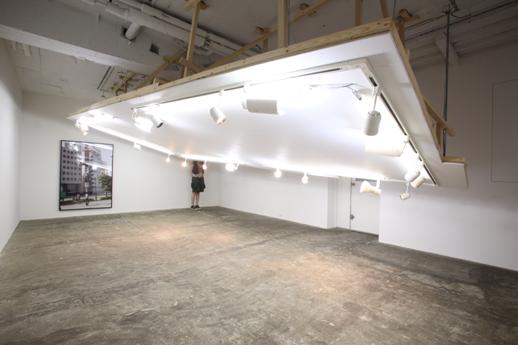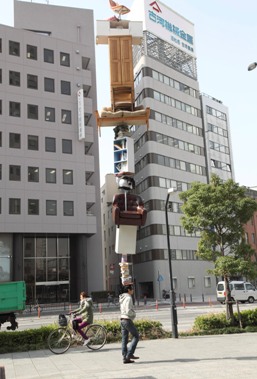Monuments Reborn in Curious Spaces Part 2
Currently showing at ARATANIURANO Gallery, Europe-based artist Tatzu Nishi’s sculpture and installation work is acclaimed for his striking use of exterior spaces. He told TABlog about some of his other projects and about the differences between working in Japan and Europe.
This is your first gallery exhibition in Japan, whereas almost all of your previous installations were created outdoors, or in public spaces.
Yes, in the ten years I’ve been working as an artist almost all of my works have been exhibited out of doors. In the past two or three years, I’ve been approached by museums and galleries that were interested in collaborating, though. For example [there was] my installation for the Liverpool Biennale (2002), which enclosed [a] statue of Queen Victoria with a temporary hotel room that visitors could actually stay in for the two-and-a-half month duration of the Biennale. We started accepting reservations about two to three weeks before, at a price of ¥8000 per night, and all the slots were snapped up almost immediately.
Were the guests mostly from the art world?
Not at all – most of them were probably Liverpool residents who wanted to see what it would be like to stay in a “hotel” built around a monument that they were very familiar with. I think there were also daughters whose mums were in town to visit who took rooms, and people who held their silver wedding anniversary party there.
What about regular visitors to the Biennale? Were they also able to enter the installation?
During the day, it was open to anyone. Those who made reservations to stay overnight checked in at 7pm, and checked out at 10am the next day – during which “Villa Victoria” became a completely private space where you could spend a night together with the Queen…! Because it was a “real” hotel, we also had a housekeeper come in to clean the rooms before the next guest checked in, and after someone checked out.
So it was really neither a public nor a private space.
You could say that, I suppose. What I was trying to do was to attempt to transform a monument and the public square surrounding it into the private space of a hotel room.

What I thought was most interesting about your previous work is how it mainly incorporates monuments and bronze statues in an effort to draw attention to these neglected objects.
This Queen Victoria statue, for example, stands right smack in the middle of Liverpool, about a two or three minute walk from the city hall. The space in which it stands in, though, is hardly used at all. There are pigeon droppings all over the Queen’s head, and the only people who come by are junkies and homeless people. I had no intention of trying to chase them away from the place, but I thought it was a shame that such a wonderful space in the center of the city was being used only by these people. The work was a proposal to use the space in a different way.
I realized that what was distinctive about both hotels and port cities was the transient nature of the people who passed through them, so I decided to create this temporary hotel for the Liverpool Biennale.
The Liverpool square that the Queen Victoria statue stands in was originally conceived as a public space that gradually fell into disuse. What I find especially powerful about your work is its ability to cause these spaces to be reborn. Are there many similar disused spaces in Germany, where you’ve been living?
I’m sure there are plenty of these neglected spaces around the world. While these may be in decline, slick and polished public squares are being built at the same time, too. There are sculptures and monuments of former mayors, kings and homegrown artists all over Europe, not just in Germany: they get built in front of train stations, in city centers, in front of the city hall – basically, wherever people tend to gather. These monuments were probably a focal point of those spaces when they were first built, but when the people who live in that town pass by them every day, they slowly forget that these things are there in the first place.
They’ve dissolved into the context of everyday life, as they say. More than that, though, I think people are just basically fickle: they easily get tired of things. Or perhaps we just couldn’t get along with life if we didn’t get sick of things. That’s how we forget about things that we see on a daily basis, stop paying them any attention.
While I was realizing this project, I happened to pass by a group of middle school kids on a class trip. The curator who was with them was asking them where the monument was, but no one was able to answer. This was in spite of the fact that it was standing in the most obvious place, right in the middle of the city.
I encountered the same sort of situation while I was preparing for the first project I ever did, in Cologne in 1997. Among the visitors to whom I was explaining what I had done, there were a number of businessmen who pass by the sculpture I was talking about everyday on their way to and from work, who said that this was the first time they were made to even realize that the thing existed. This huge statue, that had been built even before they were born!
I think art has always given people new ways of looking at things, but it also allows them to make new discoveries about objects that have always been around.
 Are reactions from European and Japanese audiences very different?
Are reactions from European and Japanese audiences very different?
Europeans tend to be more open, so people who really like my work come up to shake my hand, or even give me presents. Compared to the Japanese, I guess you could say their responses are sometimes over the top… On the other hand, those who react badly get extremely upset – with how their tax money was being used to fund my work, or how I inflicted this weird-looking installation on their favorite park. Both in Japan and Europe, though, the opinions of people who see my work are always split right down the middle when it’s first unveiled. They either really love it, or hate what it does. At openings, though, almost everyone seems to have a positive reaction. There were even a couple of groups who campaigned against my work when they caught wind of what I was going to do, but then grew to like it when they actually went to see the finished installation. They changed their minds completely, and even started to help publicize what I was doing.
Except for the Kaihoutei pavilion installation that I made for the 2005 Yokohama Triennale in the city’s Chinatown district, in Japan I don’t think I have ever encountered such an extreme reaction on the same scale.
Once in a long while, though, foreign viewers will just pass by my work without a second glance, as if it wasn’t there – a reaction that usually only comes from Japanese audiences. Maybe it’s because they don’t want to get too involved with anything that exceeds their tolerance level as far as art is concerned.
I don’t think a work that receives a positive response from a lot of people is necessarily a good one, but the whole reason why I moved my art out of galleries and museums was because I wanted to show it to people who wouldn’t otherwise ordinarily be interested in art. I’m encouraged whenever a crowd of so-called laymen comes to see what I’ve done. But this is something completely different from the art world per se, of course.
The next time someone approaches you about making an installation in Japan, I’m guessing you would pick a space or monument that would generate the most attention from the general public?
I wouldn’t necessarily choose a place that would attract the most attention, but as it turns out the project that I’m currently working on happens to be precisely that.
The projects I’ve undertaken in Japan so far have all run into problems with the local authorities in terms of obtaining official permission, which is why almost all of them were built on top of privately owned buildings. So I’d like to focus on a completely public space this time around, creating an installation around a bronze statue – something that has never been accomplished before in this country. This is a project that I initiated myself – something that I haven’t done in a long while.
Whether it’ll actually get off the ground and get completed is another thing entirely, but whatever happens I’m grateful that so many people have come forward to offer their support.
For more, see part one of this interview.
Darryl Jingwen Wee
Darryl Jingwen Wee



